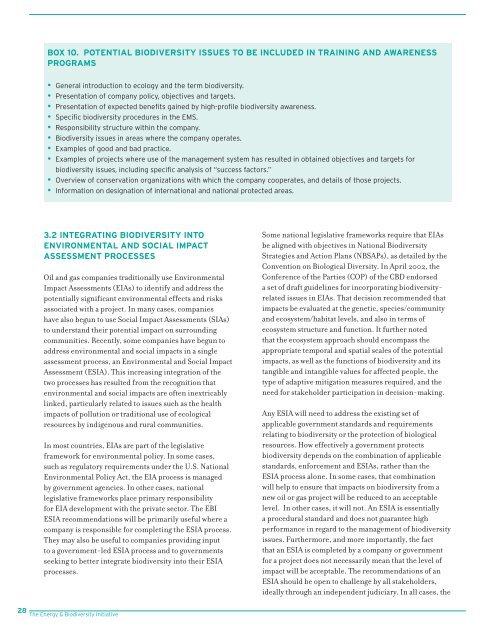Integrating Biodiversity Conservation into Oil and Gas ... - EBI
Integrating Biodiversity Conservation into Oil and Gas ... - EBI
Integrating Biodiversity Conservation into Oil and Gas ... - EBI
Create successful ePaper yourself
Turn your PDF publications into a flip-book with our unique Google optimized e-Paper software.
BOX 10. POTENTIAL BIODIVERSITY ISSUES TO BE INCLUDED IN TRAINING AND AWARENESS<br />
PROGRAMS<br />
• General introduction to ecology <strong>and</strong> the term biodiversity.<br />
• Presentation of company policy, objectives <strong>and</strong> targets.<br />
• Presentation of expected benefits gained by high-profile biodiversity awareness.<br />
• Specific biodiversity procedures in the EMS.<br />
• Responsibility structure within the company.<br />
• <strong>Biodiversity</strong> issues in areas where the company operates.<br />
• Examples of good <strong>and</strong> bad practice.<br />
• Examples of projects where use of the management system has resulted in obtained objectives <strong>and</strong> targets for<br />
biodiversity issues, including specific analysis of “success factors.”<br />
• Overview of conservation organizations with which the company cooperates, <strong>and</strong> details of those projects.<br />
• Information on designation of international <strong>and</strong> national protected areas.<br />
3.2 INTEGRATING BIODIVERSITY INTO<br />
ENVIRONMENTAL AND SOCIAL IMPACT<br />
ASSESSMENT PROCESSES<br />
<strong>Oil</strong> <strong>and</strong> gas companies traditionally use Environmental<br />
Impact Assessments (EIAs) to identify <strong>and</strong> address the<br />
potentially significant environmental effects <strong>and</strong> risks<br />
associated with a project. In many cases, companies<br />
have also begun to use Social Impact Assessments (SIAs)<br />
to underst<strong>and</strong> their potential impact on surrounding<br />
communities. Recently, some companies have begun to<br />
address environmental <strong>and</strong> social impacts in a single<br />
assessment process, an Environmental <strong>and</strong> Social Impact<br />
Assessment (ESIA). This increasing integration of the<br />
two processes has resulted from the recognition that<br />
environmental <strong>and</strong> social impacts are often inextricably<br />
linked, particularly related to issues such as the health<br />
impacts of pollution or traditional use of ecological<br />
resources by indigenous <strong>and</strong> rural communities.<br />
In most countries, EIAs are part of the legislative<br />
framework for environmental policy. In some cases,<br />
such as regulatory requirements under the U.S. National<br />
Environmental Policy Act, the EIA process is managed<br />
by government agencies. In other cases, national<br />
legislative frameworks place primary responsibility<br />
for EIA development with the private sector. The <strong>EBI</strong><br />
ESIA recommendations will be primarily useful where a<br />
company is responsible for completing the ESIA process.<br />
They may also be useful to companies providing input<br />
to a government-led ESIA process <strong>and</strong> to governments<br />
seeking to better integrate biodiversity <strong>into</strong> their ESIA<br />
processes.<br />
Some national legislative frameworks require that EIAs<br />
be aligned with objectives in National <strong>Biodiversity</strong><br />
Strategies <strong>and</strong> Action Plans (NBSAPs), as detailed by the<br />
Convention on Biological Diversity. In April 2002, the<br />
Conference of the Parties (COP) of the CBD endorsed<br />
a set of draft guidelines for incorporating biodiversityrelated<br />
issues in EIAs. That decision recommended that<br />
impacts be evaluated at the genetic, species/community<br />
<strong>and</strong> ecosystem/habitat levels, <strong>and</strong> also in terms of<br />
ecosystem structure <strong>and</strong> function. It further noted<br />
that the ecosystem approach should encompass the<br />
appropriate temporal <strong>and</strong> spatial scales of the potential<br />
impacts, as well as the functions of biodiversity <strong>and</strong> its<br />
tangible <strong>and</strong> intangible values for affected people, the<br />
type of adaptive mitigation measures required, <strong>and</strong> the<br />
need for stakeholder participation in decision-making.<br />
Any ESIA will need to address the existing set of<br />
applicable government st<strong>and</strong>ards <strong>and</strong> requirements<br />
relating to biodiversity or the protection of biological<br />
resources. How effectively a government protects<br />
biodiversity depends on the combination of applicable<br />
st<strong>and</strong>ards, enforcement <strong>and</strong> ESIAs, rather than the<br />
ESIA process alone. In some cases, that combination<br />
will help to ensure that impacts on biodiversity from a<br />
new oil or gas project will be reduced to an acceptable<br />
level. In other cases, it will not. An ESIA is essentially<br />
a procedural st<strong>and</strong>ard <strong>and</strong> does not guarantee high<br />
performance in regard to the management of biodiversity<br />
issues. Furthermore, <strong>and</strong> more importantly, the fact<br />
that an ESIA is completed by a company or government<br />
for a project does not necessarily mean that the level of<br />
impact will be acceptable. The recommendations of an<br />
ESIA should be open to challenge by all stakeholders,<br />
ideally through an independent judiciary. In all cases, the<br />
28 The Energy & <strong>Biodiversity</strong> Initiative
















![[PDF] Community Development Toolkit - CommDev](https://img.yumpu.com/48616495/1/184x260/pdf-community-development-toolkit-commdev.jpg?quality=85)
